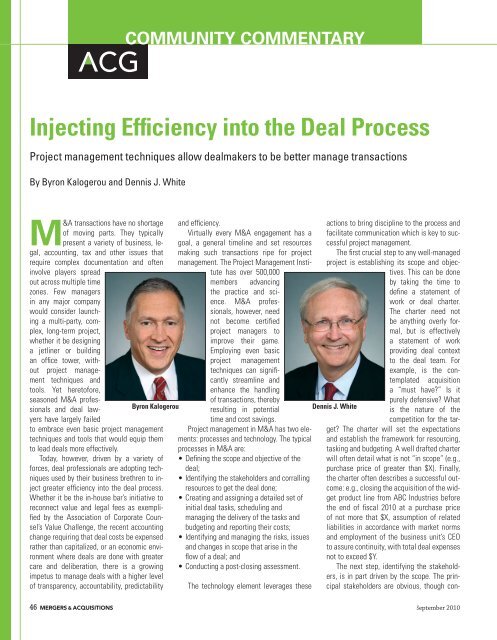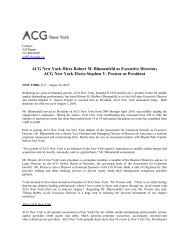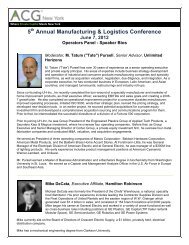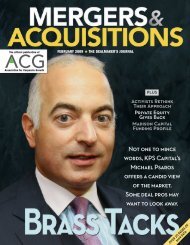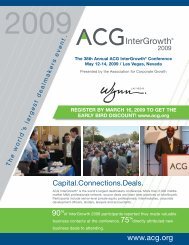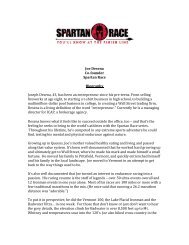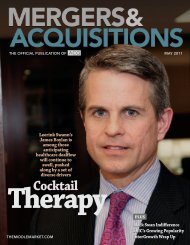September 2010 - Association for Corporate Growth
September 2010 - Association for Corporate Growth
September 2010 - Association for Corporate Growth
Create successful ePaper yourself
Turn your PDF publications into a flip-book with our unique Google optimized e-Paper software.
COMMUNITY COMMENTARY<br />
Injecting Efficiency into the Deal Process<br />
Project management techniques allow dealmakers to be better manage transactions<br />
By Byron Kalogerou and Dennis J. White<br />
M&A transactions have no shortage and efficiency.<br />
actions to bring discipline to the process and<br />
of moving parts. They typically Virtually every M&A engagement has a facilitate communication which is key to successful<br />
project management.<br />
present a variety of business, legal,<br />
goal, a general timeline and set resources<br />
accounting, tax and other issues that<br />
require complex documentation and often<br />
involve players spread<br />
making such transactions ripe <strong>for</strong> project<br />
management. The Project Management Institute<br />
has over 500,000<br />
The first crucial step to any well-managed<br />
project is establishing its scope and objectives.<br />
This can be done<br />
out across multiple time<br />
members advancing<br />
by taking the time to<br />
zones. Few managers<br />
the practice and science.<br />
define a statement of<br />
in any major company<br />
M&A profes-<br />
work or deal charter.<br />
would consider launching<br />
a multi-party, complex,<br />
long-term project,<br />
whether it be designing<br />
a jetliner or building<br />
sionals, however, need<br />
not become certified<br />
project managers to<br />
improve their game.<br />
Employing even basic<br />
The charter need not<br />
be anything overly <strong>for</strong>mal,<br />
but is effectively<br />
a statement of work<br />
providing deal context<br />
an office tower, without<br />
project management<br />
to the deal team. For<br />
project manage-<br />
techniques can signifi-<br />
example, is the con-<br />
ment techniques and<br />
cantly streamline and<br />
templated acquisition<br />
tools. Yet hereto<strong>for</strong>e,<br />
enhance the handling<br />
a “must have?” Is it<br />
seasoned M&A professionals<br />
and deal law-<br />
Byron Kalogerou resulting in potential<br />
Dennis J. White is the nature of the<br />
of transactions, thereby<br />
purely defensive? What<br />
yers have largely failed<br />
to embrace even basic project management<br />
techniques and tools that would equip them<br />
to lead deals more effectively.<br />
Today, however, driven by a variety of<br />
<strong>for</strong>ces, deal professionals are adopting techniques<br />
used by their business brethren to inject<br />
greater efficiency into the deal process.<br />
Whether it be the in-house bar’s initiative to<br />
reconnect value and legal fees as exemplified<br />
by the <strong>Association</strong> of <strong>Corporate</strong> Counsel’s<br />
Value Challenge, the recent accounting<br />
change requiring that deal costs be expensed<br />
rather than capitalized, or an economic environment<br />
where deals are done with greater<br />
care and deliberation, there is a growing<br />
impetus to manage deals with a higher level<br />
of transparency, accountability, predictability<br />
time and cost savings.<br />
Project management in M&A has two elements:<br />
processes and technology. The typical<br />
processes in M&A are:<br />
• Defining the scope and objective of the<br />
deal;<br />
• Identifying the stakeholders and corralling<br />
resources to get the deal done;<br />
• Creating and assigning a detailed set of<br />
initial deal tasks, scheduling and<br />
managing the delivery of the tasks and<br />
budgeting and reporting their costs;<br />
• Identifying and managing the risks, issues<br />
and changes in scope that arise in the<br />
flow of a deal; and<br />
• Conducting a post-closing assessment.<br />
The technology element leverages these<br />
competition <strong>for</strong> the target?<br />
The charter will set the expectations<br />
and establish the framework <strong>for</strong> resourcing,<br />
tasking and budgeting. A well drafted charter<br />
will often detail what is not “in scope” (e.g.,<br />
purchase price of greater than $X). Finally,<br />
the charter often describes a successful outcome:<br />
e.g., closing the acquisition of the widget<br />
product line from ABC Industries be<strong>for</strong>e<br />
the end of fiscal <strong>2010</strong> at a purchase price<br />
of not more that $X, assumption of related<br />
liabilities in accordance with market norms<br />
and employment of the business unit’s CEO<br />
to assure continuity, with total deal expenses<br />
not to exceed $Y.<br />
The next step, identifying the stakeholders,<br />
is in part driven by the scope. The principal<br />
stakeholders are obvious, though con-<br />
46 MERGERS & ACQUISITIONS <strong>September</strong> <strong>2010</strong>


